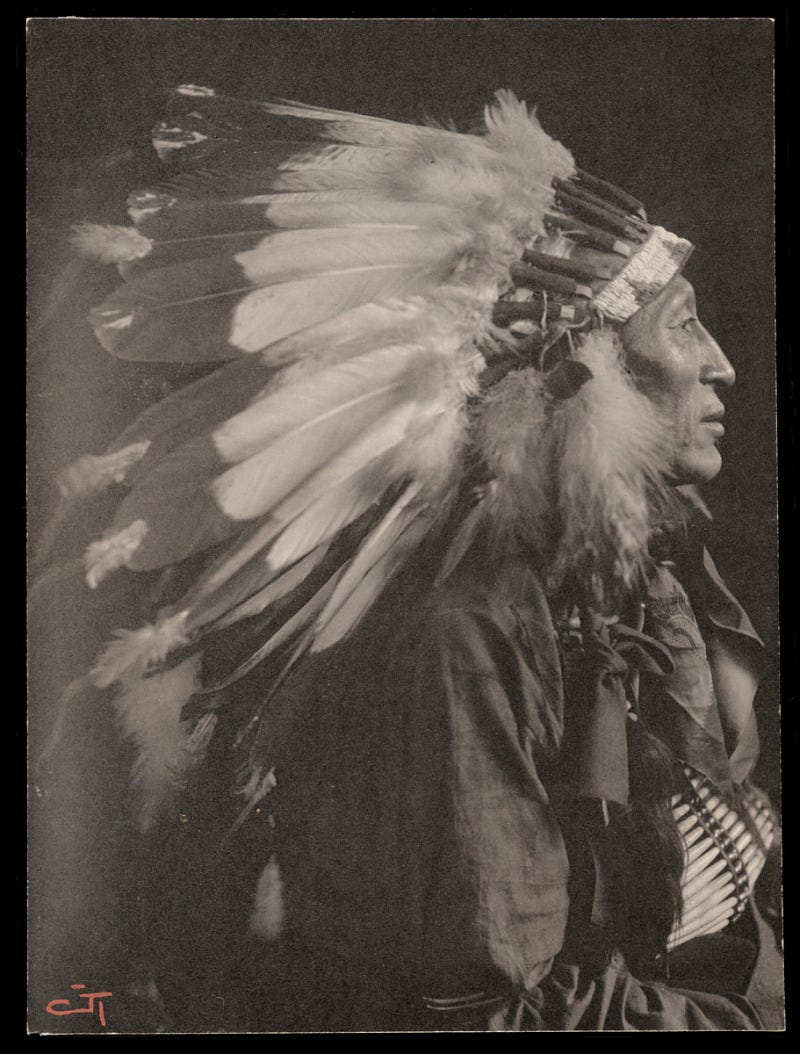Learning about cultural appropriation and why it matters.
Writing that explores cultural borrowing (and stealing), a problematic fashion fave and what's on the horizon for FRD
Hello everyone,
This week’s letter profiles a popular headdress, brings you resources on cultural appropriation and shares an exciting update on what you’ll find on the database next month.
Objects That Matter: The Great Plains Feathered Headdress
The Plains Indian/First Nation feathered headdress, commonly referred to as a “war bonnet,” is one of most recognizable items of indigeneity in North America due to its prevalence in mainstream media, fashion and sports. The common misconception is that all Native Americans wore war bonnets or that they were a fashionable accessory.
In line with our examination of cultural appropriation, Research Assistant Adriana Hill took on one of the most popularly appropriated ‘accessories’– the Great Plains Feathered Headdress. We’ve seen this item on runways, in fashion editorials, on magazine covers and more. It’s fair to say that Native American culture has a long history of being appropriated and exploited. We invite you to explore Adriana’s profile of this magnificent headdress, learning its significance and how that significance has been obscured by its glamorization.

Kasebier, Gertrude. Chief Iron Tail, Sioux Indian, in Feather Headdress, 1898. Platinum print photograph, 20.1 cm x 14.9 cm. National Museum of American History, Work and Industry: Photographic History, PG.69.236.039. CC-BY (Photo: National Museum of American History).
Is there an object you’d like to write about and add to our growing canon of marginalized or mis-appropriated fashion? Pitch the object via our contributor page.
The Library: Cultural Appropriation
Our Library provides an ever-expanding collection of resources on ‘race,’ with its ideological and aesthetic influence shaping both history and our modern lives.
Perhaps the most contentious topic in fashion over the past ten years, cultural appropriation touches on a pressure point for many, as we grapple with the question, “who owns culture?” This is precisely the question that law scholars like Susan Scafidi pose as we are immersed in a globalized society, and philosophers like James O. Young examine through the ethical implications of appropriating culture outside of one’s own lived experience–for the sake of art and inspiration.
Yet, when it comes to why people grow upset over cultural appropriation–particularly in the world of fashion–it’s a matter of power dynamics, most notably articulated by scholar Minh-Ha T. Pham. Pham, who has written that she is exhausted with the discourse on cultural appropriation, seeks to further complicate and interrogate the mechanisms of cultural and material borrowing–calling it ‘racial plagiarism.’
All of this said, the key issue we hope to address here is that privilege and the balance of power (between individuals, cultures) must be in the purview each time we see an object or style borrowed. There must be a personal line of questioning: Who/Where did this come from? What is its history and significance? Will my borrowing/inspiration of this object or style cause harm?

Still image from the Victoria’s Secret Fashion Show, 2012.
Let’s research cultural appropriation together. Here’s a few items from our shelf to get you started:
White Negroes: When Cornrows Were in Vogue… and Other Thoughts on Cultural Appropriation by Lauren Michele Jackson (book)
Who Owns Culture? Appropriation and Authenticity in American Law by Susan Scafidi (book)
‘Native/American Fashion: Inspiration, Appropriation, and Cultural Identity’ by Adrienne Keene (filmed talk)
Cultural Appropriation and the Arts by James O. Young (book)
‘Racial Plagiarism and Fashion’ by Minh-Ha T. Pham (article)
We add new sources weekly, so head over to The Library for a full spectrum of books, articles, videos and podcast episodes that further address this topic.
Coming Soon: Essays, Opinion & Guest Posts for ‘Objects That Matter’
You’ve probably noticed that our ‘Essays & Opinion’ section is a little bare. Well, thanks to all of the pitches for new content that we have received over the past two months and substantial fundraising efforts, we are excited to share that you can expect to see numerous original essays, Op-ed pieces and guest posts for our ‘Objects That Matter’ section as soon as next month!
We are elated to have a platform that will house original content written by BIPOC writers, students, designers and scholars and also be able to compensate them. Compensation was a priority for us, as many academic and editorial spaces do not offer compensation for intellectual labor. When it comes to topics like ‘race,’ this content also requests emotional labor from a writer, so it’s important that our database doubles as a safe and supportive space.
We also plan to publish content from non-BIPOC writers/scholars (our allies and accomplices) further down the line as it seems fit, and we already house several non-BIPOC sources in The Library. We want to make it clear that when it comes to decentralizing and decolonizing fashion, all relevant content is necessary for examination and fully understanding the discourse.
See you next week! Yours in service and solidarity,
The Project Team
(Kim, Rachel, Adriana, Safia)



